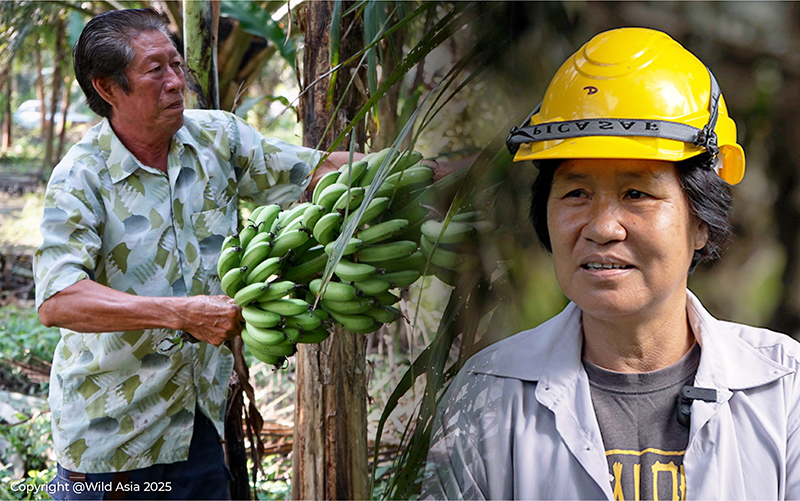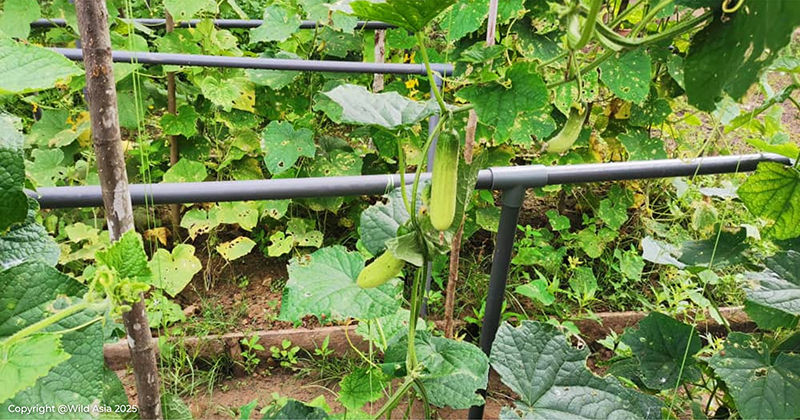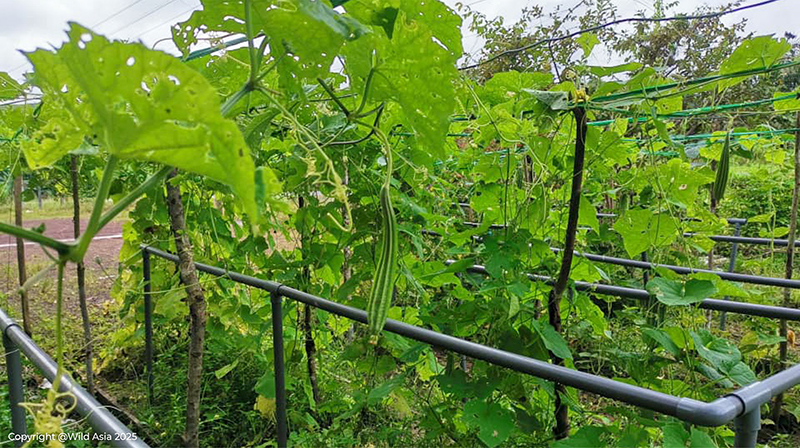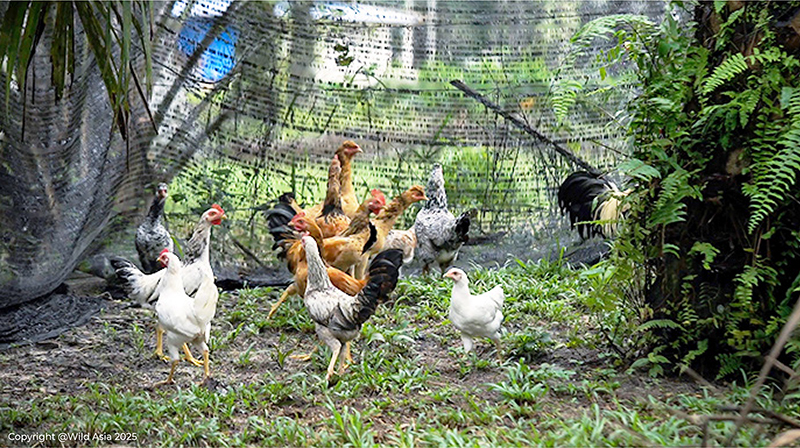Innovations in Practice: Building Resilience in Smallholder Farmers (Part 2)
Beyond helping independent smallholders boost sustainable oil palm production, Wild Asia empowers them through alternative income-generating enterprises. In Part 2, we highlight independent smallholders in Peninsular Malaysia who are integrating crops and livestock to boost income, food security, and resilience. (Read Part 1 here)

Perak-based independent smallholders Azmah Dongkin and Lim Ah Kou embrace livestock integration and crop diversification to supplement their income.
Although these community enterprises mainly take place in Sabah, resourceful WAGS farmers in Perak who have embraced diversification are reaping the benefits, both literally and figuratively.

Indigenous Semai farmer Azmah Dongkin manages a 4-ha MSPO-certified farm in Kampung Chenderong Kelubi. In her backyard, however, she planted a cluster of oil palm trees organically, alongside vegetables and fruit trees. A flock of ayam kampung (free-range chickens) happily roam amidst clumps of pandan (Pandanus amaryllifolius), moringa, water spinach, pineapple and peanut bushes, as well as papaya and banana trees.
“I’ve never used any chemicals on this 0.01 ha-plot since I started growing the edible garden in 2013,” says Azmah, who sells her chickens, bananas and pineapples for extra income. “My chickens love to peck on the earthworm-rich soil. Compared to my other farm, the palm trees are visibly healthier with bright, green fronds and large, dense fruits.”
About 20km south of Chenderong Kelubi, independent smallholder Lim Ah Kou has been intercropping bananas with oil palm on his 2-acre farm near Langkap town since 1998.
“A friend told me it’s just one of many ways to maximise land use and earn extra income,” says the WAGS farmer. Lim planted 100 trees from different banana varieties like pisang berangan (Musa acuminata), pisang tanduk (Musa paradisiaca) and pisang raja (Musa acuminata × balbisiana). At the same time, he planted his palm seedlings. Even as his palm trees matured, he continued to grow bananas, ensuring they had sufficient space to receive direct sunlight.
“They (bananas) don’t require much maintenance. I apply chicken manure and commercial fertiliser on both the palm and banana trees,” says the MSPO-certified farmer. In 2014, he also intercropped bananas with oil palm in a newly purchased 3-acre plot. As recently as 2019, he was still manually controlling weeds. But with age, the 75-year-old recently switched to using herbicides due to the intensive labour.

Farmers apply regenerative farming practices learned from the WAGS BIO programme to their home gardens, growing healthy, nutritious vegetables for their families. Pictured here is Nisa Usman’s garden in Kampung Paris, Kinabatangan, Sabah — featured in PalmSphere, Volume 11.
“Both the palms and bananas seem to grow well, and thankfully, my palm trees haven’t been plagued by any disease outbreak so far,” says Lim. In fact, his FFB yield averages 29.62 mt per hectare per year, significantly above the national average of 16.7 tonnes (2024 figures; MPOB).
Although Lim does not keep track of his banana sales, each harvest cycle yields a minimum of RM5,000 or higher (calculations based on the wholesale market price, weight per bunch, and number of trees).
In recent years, Lim’s number of banana trees has declined by 40% due to theft, pests (such as macaques), and diseases. He recently sold the 3-acre farm and is now left with a 0.8-hectare oil palm plot and about 60 banana trees.
“Unless I build a fence around my farm, I can’t stop people from stealing my bananas just when they’re ripe for harvesting. It’s frustrating,” he admits.
Crop Diversification Studies
Findings from farmer surveys in Malaysia and Indonesia have shown that oil palm production can be more inclusive for smallholders when it addresses their diverse livelihood needs and resilience.
Smallholder inclusivity has always been defined as the access to the global palm oil supply chain. However, researchers in this study argue that to further enhance smallholder inclusivity, palm oil production systems need to address smallholder livelihoods in terms of crop choices that fit their household needs for food or for income, by connecting to marketing options and longer value chains. This would lower dependency on palm oil price swings and improve livelihood resilience from a diversity of income sources.

Conventionally, farmers would plant other crops between rows of oil palm seedlings. When the palm fronds and roots are small, sufficient sunlight can reach the ground, and the palm roots do not compete for nutrients. However, as the fronds grow bigger and start to overlap with adjacent palm trees, the conditions become suboptimal for crop integration. Farmers would remove other crops once the palm trees begin to mature, typically after three years old.
To extend the duration of crop integration, the study recommends planting oil palm in two rows for every avenue. The planting distance between the palms in the same row is 6.1 m and 9.1 m between rows, while the distance between two avenues is 15.2 m - making it wide enough to plant other crops. The plant density in the double-row system is 136 palms per hectare, which is similar to the standard planting configuration system (9.1m x 9.1m x 9.1m).

In a four-year trial of black pepper integration with oil palm using the double-row avenue system (Raja Zulkifli et al. 2016) in MPOB Research Stations in Belaga, Sarawak and Keratong, Pahang, researchers found that there is no significant difference in FFB yields between oil palm-black pepper integration plots and control plots. Integration of black pepper “optimises oil palm land utilisation and provides additional long-term income to the growers.” However, farmers need to maintain the integrated crop using “good agricultural practices” proposed in the research.
Reality Checks
However, it is one thing to initiate an income or crop diversification programme; sustaining farmers’ interest and commitment is another story.
“During lockdown, many farmers had time on their hands, so they were willing to learn and start their home gardens. It was a success,” says Wild Asia Director and Advisor Peter Chang. “The dynamics changed tremendously after the lockdown was lifted. The home gardens were neglected because everyone had no time due to other commitments.”
Out of 36 farmers who participated in the home garden workshop, 11 farmers are still tending their home gardens today, four years on.
“Also, when FFB prices are high, smallholders tend to lean towards maximising oil palm production due to immediate returns and the lower labour demands compared to crop diversification, which is also influenced by external factors,” Chang adds.
As for Nisa, she tended her home garden for 18 months before quitting due to a lack of time. Once the pandemic was over, she resumed her active role in Puspanita (women’s association) events and activities.

Farmers who learn natural farming practices for their oil palm blocks often carry those skills into their home gardens. Here, Nisa Usman of Kampung Paris, Kinabatangan, Sabah puts WAGS BIO training into practice—featured in PalmSphere, Volume 11.
Profits from her lucrative mushroom business more than offset her household expenses.
“I’m thinking of restarting my home garden again. Nothing beats feeding my family healthy food grown at home,” Nisa mulls. Now that all her children, ranging in age from 21 to 33, are working adults, she has more time on her hands.
“More importantly, I look forward to learning more from BIO and finding alternative income opportunities.”
Moving Forward
More than just imparting tools and techniques, initiatives like WAGS BIO strive to inspire farmers to transcend conventional practices and explore new possibilities.
“Crop diversification and regenerative farming are more than just strategies; they represent a pathway to resilience, self-sufficiency, and empowerment,” says Wild Asia Founder and Executive Director Dr Reza Azmi. However, the journey is not without its challenges. Sustaining farmer interest, integrating practices into daily life, and scaling efforts to reach more smallholders require continuous innovation, collaboration, and commitment from various stakeholders.
“We are committed to supporting smallholder farmers, not only in improving their livelihoods but also in fostering sustainable communities,” Reza sums up.
“The ripple effect of these efforts can lead to healthier ecosystems, resilient farming systems, and empowered farmers who see themselves not just as producers but as stewards of the land.”

Farmer Azmah Dongkin’s chickens roam freely on her chemical-free oil palm farm, and feed on the earthworm-rich soil.






